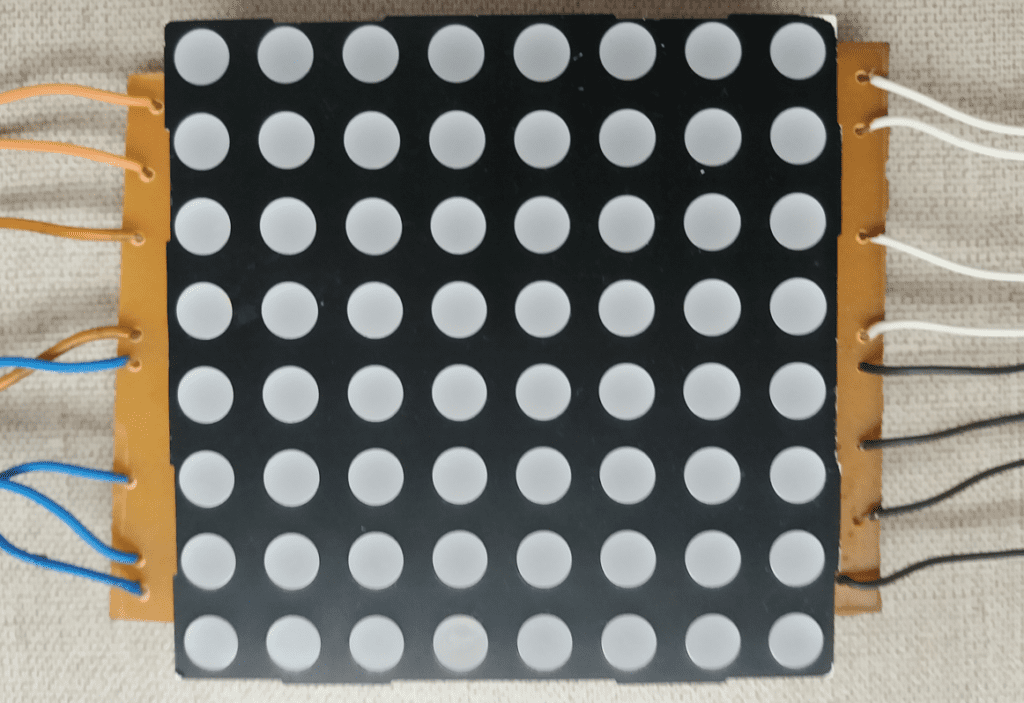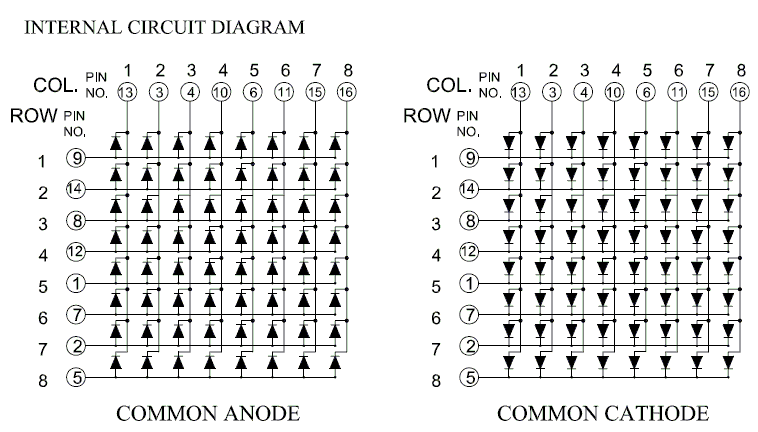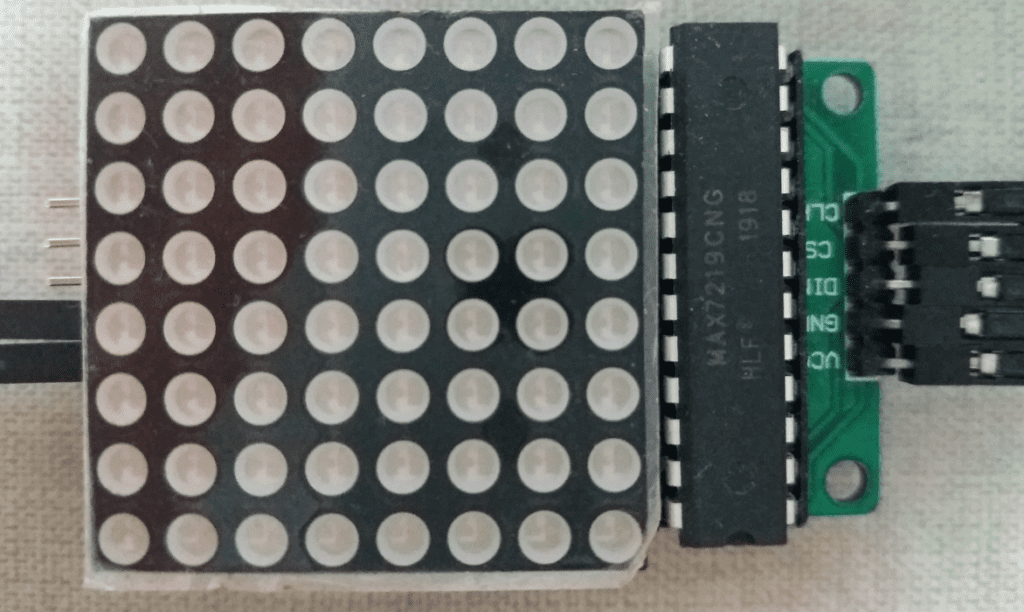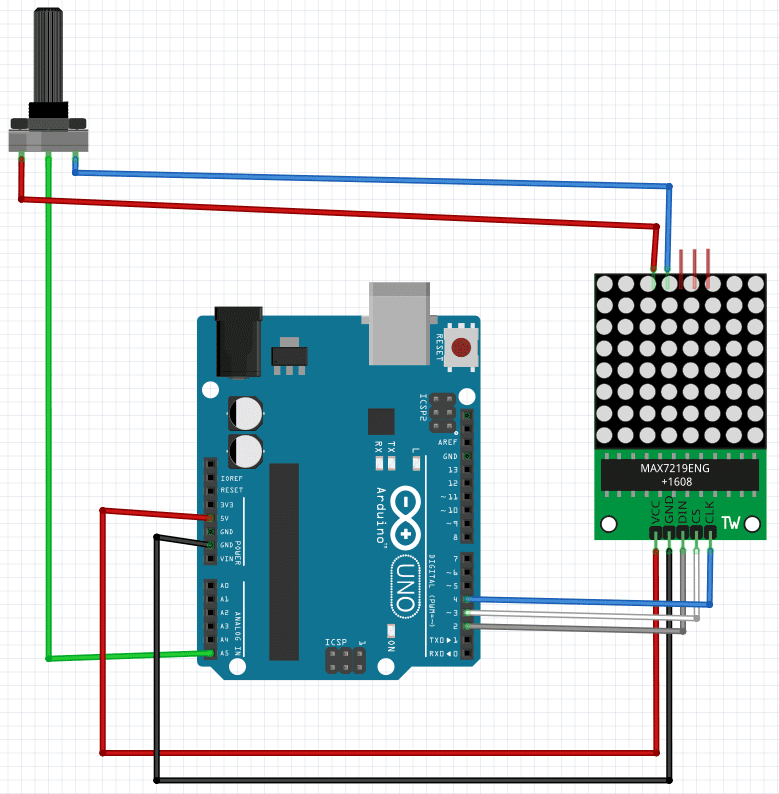This is a project of the classic game Pong on Arduino, that shows score with horizontal rolling when finish the match.
The LED display 8×8

This project must be made with a LED matrix 8×8, this matrix has 16 inputs. With this component, it’s possible to make drawings, simple animations, write letters, numbers and create games.

To use LED matrix you must use multiplexing. This concept will be explained in a future post.
The MAX7219 module

This module was created to facilitate the assembly of projects with LED display, just need to connect 5 wires to Arduino: 2 for power supply (Vcc and GND) and other 3 terminals which are:
- DIN: data input.
- CLK: clock.
- CS: pin that transfer data to the display.
Without this module, would be necessary too many wires for connection. The operation of integrated circuit MAX7219 will be explained in another post. The focus here is how to build the game Pong.
The Pong game
The necessary materials to build the project are: one Arduino Uno, a module MAX7219 and a 10 kΩ. potentiometer.

The player controls the racket with the potentiometer. The code is based on project 22, chapter 7, of Beginning Arduino, by Michael McRoberts.

The difference is that the presented project in this post has a horizontal rolling message indicating how many points the players scored when the match is finished. The code below, to download the library “LedControl.h”, click here.
#include "LedControl.h"//Include library to control //the MAX7219 matrix.
LedControl myMatrix = LedControl(2, 4, 3, 1);//Creates a matrix //instance.
/* DIN -> Arduino Digital 2
CS -> Arduino Digital 3
CLK -> Arduino Digital 4
The forth digit indicates that I'm using only 1 MAX7219 module.
*/
// 1.Global variables ---
int column = 1, row = random(8)+1; //Decides which point the ball must //start.
int directionX = 1, directionY = 1; //Certificates that the ball go first //from right to left.
int paddle1 = 5, paddle1Val; //Pin and potentiometer value.
int velocidade = 300; //Ball's initial speed.
int counter = 0, mult = 10;
char score[4]; // Variable to convert int counter in char.
// end 1. ---
//2.Initial settings ----
// Variables used for rolling score, both start on 0.
int index = 0; // Current char to be shown.
int shift = 0; // Quantity of shifting columns.
// Array to store bit map to be shown.
int bitsMap[] = {0,0,0,0,0,0,0,0};
// Vector with power of 2 to calculate what to show.
const int twoPowers[] = {1,2,4,8,16,32,64,128};
int charachter;
#define displayspeed 7 //Score exhibition speed, less is faster.
//End 2. ----
//How numbers must appear on display.
const int zero[]={B00111100,
B01000010,
B01000010,
B01000010,
B01000010,
B01000010,
B00111100,
B00000000};
const int one[]={B00001000,
B00011000,
B00101000,
B00001000,
B00001000,
B00001000,
B00111110,
B00000000};
const int two[]={B00011000,
B00100100,
B00100100,
B00001000,
B00010000,
B00100000,
B00111100,
B00000000};
const int three[]={B00111100,
B01000010,
B00000010,
B00111100,
B00000010,
B01000010,
B00111100,
B00000000};
const int four[]={B00000100,
B00001100,
B00010100,
B00100100,
B01111111,
B00000100,
B00000100,
B00000000};
const int five[]={B01111110,
B01000000,
B01111000,
B00000100,
B00000010,
B00000010,
B01111100,
B00000000};
const int six[]={B00111100,
B01000000,
B01000000,
B01111100,
B01000010,
B01000010,
B00111100,
B00000000};
const int seven[]={B01111100,
B00000100,
B00000100,
B00011111,
B00000100,
B00000100,
B00000100,
B00000000};
const int eight[]={B00111100,
B01000010,
B01000010,
B00111100,
B01000010,
B01000010,
B00111100,
B00000000};
const int nine[]={B00111100,
B01000010,
B01000010,
B00111110,
B00000010,
B00000010,
B01111100,
B00000000};
void setup()
{
myMatrix.shutdown(0, false); //Habilitate display.
myMatrix.setIntensity(0, 8); //Define medium brightness.
myMatrix.clearDisplay(0); //Clear display.
randomSeed(analogRead(0)); //Creates a random seed.
Serial.begin(9600); //To appear score on serial //screen.
}
void loop()
{
paddle1Val = analogRead(paddle1);
paddle1Val = map(paddle1Val, 200, 1024, 1, 6);
column += directionX;
row += directionY;
if(column == 6 && directionX == 1 && (paddle1Val == row || paddle1Val+1 == row || paddle1Val+2 == row)) directionX = -1;
if(column == 0 && directionX == -1) directionX = 1;
if(row == 7 && directionY == 1 ) directionY = -1;
if(row == 0 && directionY == -1) directionY = 1;
if(column == 7){
oops();
}
myMatrix.clearDisplay(0); //Clears screens for the //next animation frame.
myMatrix.setLed(0, column, row, HIGH);
myMatrix.setLed(0, 7, paddle1Val, HIGH);
myMatrix.setLed(0, 7, paddle1Val+1, HIGH);
myMatrix.setLed(0, 7, paddle1Val+2, HIGH);
if(!(counter % mult)) {velocidade -= 5; mult*mult;}
delay(velocidade);
counter++;
}
void oops() //Game over function.
{
delay(1000);
if(counter<100){//If score is lower than 100.
for(int y=0; y<40; y++)
{
loadMatrix2();
drawScreen(bitsMap);
//What the serial screen must show.
Serial.println("Game Over");
Serial.print(counter);
Serial.println("\n");
Serial.println("Score:");
Serial.print(score);
Serial.println("\n");
}
}else{ //If score is higher than 100.
for(int y=0; y<40; y++)
{
loadMatrix();
drawScreen(bitsMap);
//What the serial screen must show.
Serial.println("Game Over");
Serial.print(counter);
Serial.println("\n");
Serial.println("Score:");
Serial.print(score);
Serial.println("\n");
}
}
delay(1000);
counter = 0; //Reinitiate all values.
velocidade = 300;
column = 1;
row = random(8)+1;
}
void loadMatrix(){ //Load matrix to show 3 digits.
itoa(counter,score,10); //Functions that convert int in char strings of 10 //base, to be shown at display.
getChar(score[index]); // Reads current phrase char.
int currentChar = charachter;
getChar(score[index+1]); // Reads next char.
int nextChar = charachter;
executeMatrix(currentChar, nextChar);
}
void loadMatrix2(){//Load matrix to show 1 or 2 digits.
itoa(counter,score,10);
getChar(score[0]); // Reads current phrase char..
int currentChar = charachter;
getChar(score[1]); // Reads next char.
int nextChar = charachter;
executeMatrix(currentChar, nextChar);
}
// Creates the matrix's bit map.
void executeMatrix(int currentBuffer[], int nextBuffer[]) {
for(int r=0; r < 8; r++){ // Increments r to r from 0 to 7 (row - line).
bitsMap[r] = 0; // Reset line.
for(int c=0; c < 8; c++){ // Increments c to c from 0 to 7 (column - //coluna).
bitsMap[r] = bitsMap[r] + ((twoPowers[c] & (currentBuffer[r] << shift))); // Loads current char compensated by shifting.
bitsMap[r] = bitsMap[r] + (twoPowers[c] & (nextBuffer[r] >> (8 - shift) )); // Loads the next char compensated by shifting.
}
}
shift++; // Increments the shift variable responsible by one line //shifting.
if(shift==8){
shift = 0;
index++;
//if(index == sizeof(texto)-2){
if(index == sizeof(score)-2){
index=0;
}
} // If shift is equal to 8, load the next char pair. //(currentChar and nextCahr).
}
void drawScreen(int buffer[]) {
for (int v = 0; v < displayspeed; v++) {
for (int i = 0; i < 8; i++) { // linhas
for (int j = 0; j < 8; j++) { // colunas
myMatrix.setLed(0, i, j, bitRead(buffer[i], 7 - j));
//using bitRead()
}
}
}
}
void getChar(char msgChar) {
switch(msgChar){
case '0': charachter = zero; break;
case '1': charachter = one; break;
case '2': charachter = two; break;
case '3': charachter = three; break;
case '4': charachter = four; break;
case '5': charachter = five; break;
case '6': charachter = six; break;
case '7': charachter = seven; break;
case '8': charachter = eight; break;
case '9': charachter = nine; break;
}
}


This subject is very interesting now i’m going to study more about it very good this post blog wonder.
Your website is amazing congratulations, visit mine too:
https://strelato.com
.